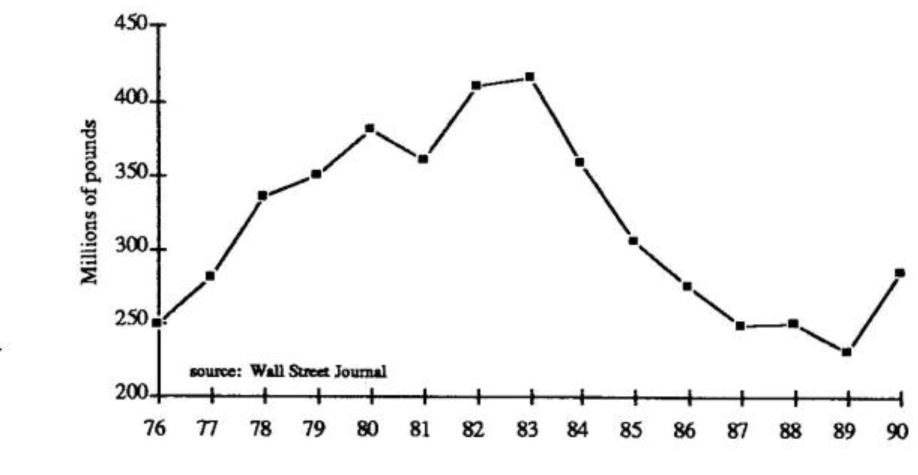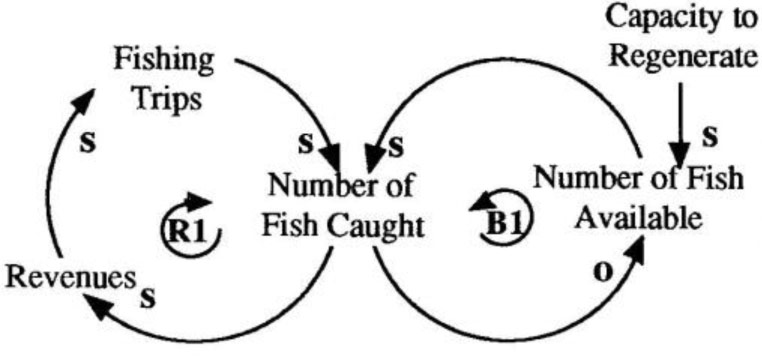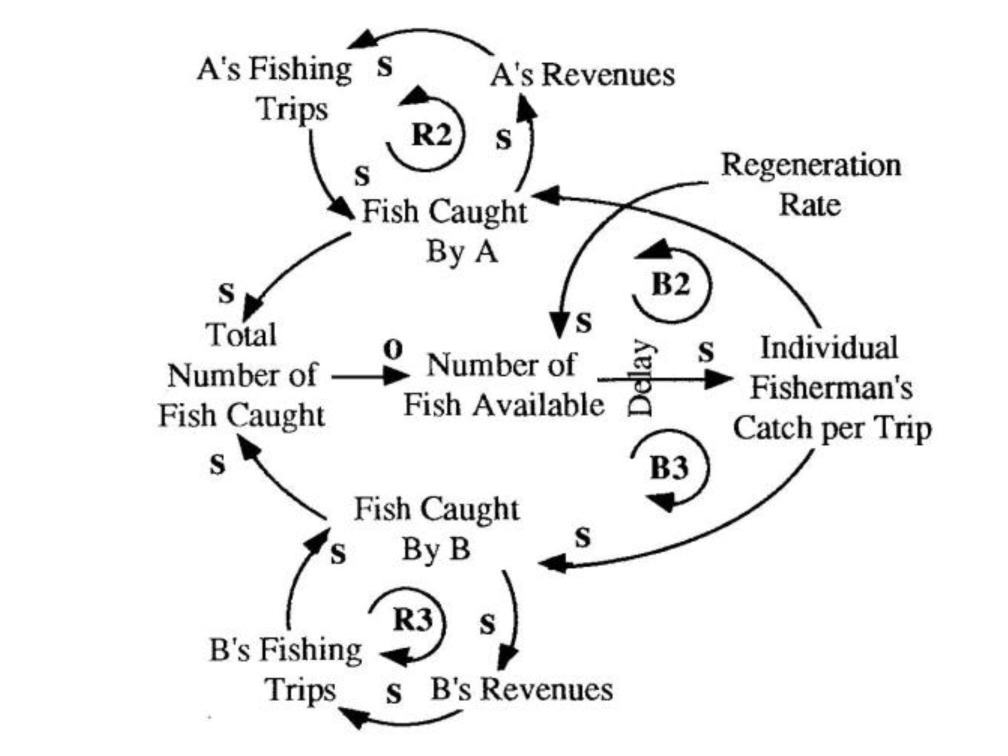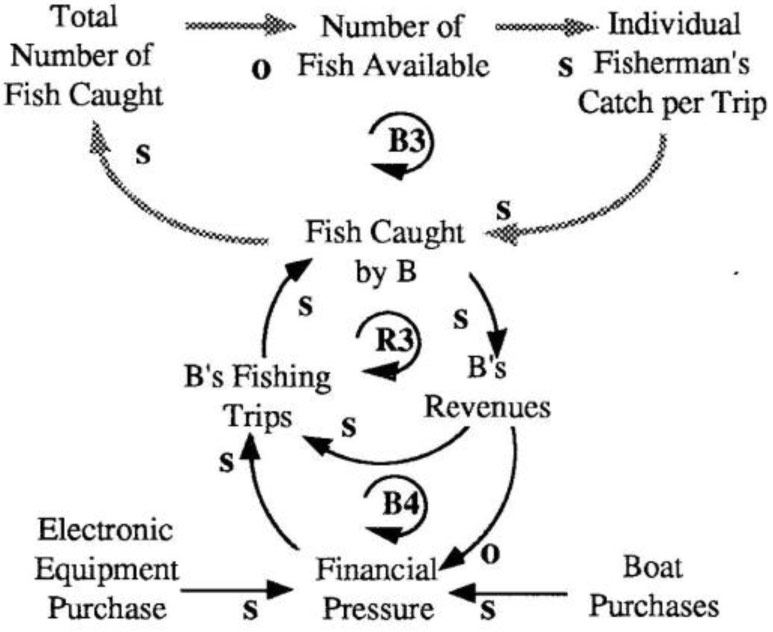New England fishermen are in trouble, victims of a “get-it-while-you-can mentality” that could exhaust fish stocks beyond recovery and threaten the existence of one of America’s oldest industries, declared a recent Wall Street Journal article. (“Dead in the Water: Overfishing Threatens to Wipe Out Species and Crush Industry,” July 16, 1991). Frustrated fishermen have watched their daily catch dwindle over the years, while the number of foreclosure auctions on boats continues to climb.
The current scenario is what U.S. government officials thought they were preventing in 1977 when they banned foreign trawlers from a 200-mile boundary around U.S. shores. The action was intended to reserve fish stocks for local fisherman. But soon local boats took the place of foreign vessels. The New England ground fishing fleet grew from 590 vessels in 1976 to more than 1,000 in the early 1980s. New, more expensive trawlers with advanced fish-fording electronics were built, making it easier to track down good fishing beds and navigate tricky waters near rocks or shipwrecks.
New England Fish Catches

In 1982, under intense pressure by fishermen, the New England Fishery Management Council lifted catch quotas and trip limits. With unlimited water usage and advanced tools, fishermen saw dramatic increases in their catches. But trawler catches peaked in 1983 at 415 million pounds, then fell off sharply (see “New England Fish Catches”). Now fishermen are scrambling to bring in catches that are smaller than any in recent memory.
Not only are the numbers of fish in each catch declining, but so is the size of each fish. Smaller fish are less likely to have spawned, thus jeopardizing future fish stocks (see “Limits to Fish Catches”). Flounder and haddock are already near record lows. The cod count is down, and bluefin tuna and swordfish have been depleted. The problem is not restricted to New England. Red snapper is declining in the Gulf of Mexico, swordfish are down in the Atlantic, and salmon are under pressure in the Pacific.
Some fishermen deny that overfishing is to blame, arguing that natural cycles are at work and the stocks will rebound in time. Others contend that pollution is the culprit, although that does not explain why unpopular fish like skate and dogfish arc flourishing.
Limits to Fish Catches

One thing is certain — fishermen, who face large mortgages on their expensive boats, feel intense pressure to fish as aggressively as they can. Many now fish longer hours in order to make up for smaller catches. Some scallop fishermen in New Bedford, for example, have begun working almost round the clock. The combination of high-tech equipment and longer working hours means “fish have no sanctuary of space or time.”
Current efforts to maintain fish stocks include setting minimum net mesh sizes and occasionally closing overfished waters. But some fishermen and conservationists are demanding stricter limits: catch quotas, trip limits, and even a moratorium on new boats. Legislation is pending that proposes reducing the fleet size by buying out boats with money from a tax on diesel fuel fishing boats use.
Discussion Questions
- How does the “Limits to Success” structure shown above play into a “Tragedy of the Commons” structure?
- What are the incentives for the fishermen to keep fishing and who controls those incentives?
- Based on your understanding of the “Tragedy of the Commons” archetype, what “solutions” would you recommend?
- Are there similar “Tragedy of the Commons” structures playing out in your organization or industry?
Although the “Limits to Fish Catches” diagram on page 7 captures the main structural elements that are responsible for the collapse of fish stocks, it lacks some key distinctions which are critical for understanding the crisis. The “Tragedy of the Commons” archetype shows how each fisherman’s actions are contributing to the declining catches (see “Tragedy of the Fishing Grounds”).
The paradoxical logic of this archetype says that each person pursuing his best interest will collectively create a future state that nobody wants. For example, if fisherman A increases his fishing trips he will increase his catch as well as his revenues (R2). The more trips he makes, the more money he makes. The same goes for fisherman B (R3). But as hundreds and hundreds of fishing boats enter the waters, the number of fish available rapidly declines, leading to smaller catches and lower revenues for everyone (B2 & B3).
Tragedy of the Fishing Grounds

The number of trips each fisherman makes is determined by his individual revenue goals. If there were other employment alternatives, the decline in revenues might actually lead to fewer fishing trips as fishermen looked for other forms of employment. For many of them, however, fishing is the only livelihood they know. Family tradition and lack of other job skills suggest that they will continue fishing. Thus as revenues sink lower, the financial pressure mounts, spurring them to increase their fishing trips. New boat and electronic equipment purchases that were made in the early 1980s only exacerbate the financial pressure (see “Incentives and Pressures”).
As fisherman B goes on more fishing trips, the amount of fish he catches will increase, thus raising the total number of fish caught. Since the number of available fish has decreased, the next time out B will catch fewer fish, resulting in lower revenues and increased financial pressure. Fisherman B will feel he has no choice but to go on even more fishing trips. Multiply that scenario by a 1000 and you have the current situation in New England — each player is being driven to fish harder, the stocks of fish are being depleted faster, and the size of the catch is growing smaller.
Altruistic Actions
Incentives and Pressures

Suppose in order to rectify this situation, I as an individual fisherman decide to cut back on the number of trips and dip into my savings to survive until the fish stocks arc replenished. How long would I have to wait? Probably a lot longer than my bank account could hold out. The reason is that the solution to a tragedy of the commons structure never lies at the individual level. My individual actions to stop fishing will simply leave my usual daily quota of fish for some other fishermen to catch.
To be effective, the solution must affect the actions of all the fishermen by linking more directly the long term losses with the current gains. Each of the proposed solutions — catch quotas, trip limits, a moratorium on new boats — shows promise, but to be truly effective they will need to be used in combination. For example, instituting a moratorium on new boats without limiting catch size or number of trips would work only if the current fleet’s capacity to fish was less than the fish’s regeneration rate, which does not seem likely according to the data. Enforcing catch quotas and trip limits without providing ways to compensate for the accompanying financial hardships will be difficult. Faced with the prospect of financial ruin, most fishermen are likely to continue fishing as hard as ever.
The plan to buy back boats using funds obtained through a diesel tax shows promise. It is the equivalent of a user fee that taxes individuals proportionate to their usage of a resource or facility, similar to toll roads or gasoline taxes that compensate for the wear and tear on roadways. From a systems perspective it has several advantages: it links the individual’s actions of today with the longer implications of those actions, and it helps distribute the financial burden over the entire fishing community.
There still are problems with this solution, however. As always, the use of a tax is unpopular with voters who are affected by it, making it politically difficult to follow through with such legislation. Even if the tax went through, it is unlikely that the revenues would be large enough to pull a significant number of boats out of circulation (the market value of all the boats is in the hundreds of millions of dollars). A matching fund of some kind may be required (a haddock tax, perhaps?) to supplement the diesel tax. Again, without accompanying measures like quotas and trip limits, the tax may only serve to increase the financial pressure, forcing everyone to fish even harder.
Adam Smith’s Invisible Hand
Our free market economy is based on Adam Smith’s theory, which argues that if everyone pursues his or her self-interest, the free market system will produce the best outcome for society as a whole. But does this theory still hold true? If the “Tragedy of the Commons” structure tells us nothing else, it says that the invisible hand theory is seriously flawed. The crisis in the fishing industry and many other “Tragedy of the Commons” structures testify to the fact that the “invisible hand” works only when individual actions are pursued in an environment that is virtually limitless relative to the impact of the collective actions. In Adam Smith’s time, that may have been true. But with the world rapidly becoming a tightly-interconnected “global village,” it may be that the invisible hand is poised to give us a slap on the face.
